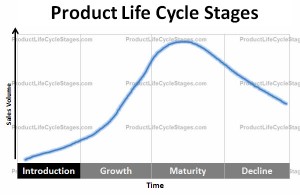 The first of the four product life cycle stages is the Introduction Stage. Any business that is launching a new product needs to appreciate that this initial stage could require significant investment. This isn’t to say that spending a lot of money at this stage will guarantee the product’s success. Any investment in research and new product development has to be weighed up against the likely return from the new product, and an effective marketing plan will need to be developed, in order to give the new product the best chance of achieving this return.
The first of the four product life cycle stages is the Introduction Stage. Any business that is launching a new product needs to appreciate that this initial stage could require significant investment. This isn’t to say that spending a lot of money at this stage will guarantee the product’s success. Any investment in research and new product development has to be weighed up against the likely return from the new product, and an effective marketing plan will need to be developed, in order to give the new product the best chance of achieving this return.
Challenges of the Introduction Stage
Small or no market: When a new product is launched, there is typically no market for it, or if a market does exist it is likely to be very small. Naturally this means that sales are going to be low to start off with. There will be occasions where a great new product or fantastic marketing campaign will create such a buzz that sales take off straight away, but these are generally special cases, and it often takes time and effort before most products achieve this kind of momentum
High costs: Very few products are created without some research and development, and once they are created, many manufacturers will need to invest in marketing and promotion in order to achieve the kind of demand that will make their new product a success. Both of these can cost a lot of money, and in the case of some markets these costs could run into many millions of dollars.
Losses, Not Profits: With all the costs of getting a new product to market, most companies will see negative profits for part of the Initial Stage of the product life cycle, although the amount and duration of these negative profits does differ from one market to another. Some manufacturers could start showing a profit quite quickly, while for companies in other sectors it could take years.
Benefits of the Introduction Stage
Limited competition: If the product is truly original and a business is the first to manufacture and market it, the lack of direct competition would be a distinct advantage. Being first could help an organisation to capture a large market share before other companies start launching competing products, and in some instances can enable a business’s brand name to become synonymous with the whole range of products, like Walkman, Biro, Tannoy and Hoover.
High Price: Manufacturers that are launching a new product are often able to charge prices that are significantly above what will eventually become the average market price. This is because early adopters are prepared to pay this higher price to get their hands on the latest products, and it allows the company to recoup some of the costs of developing and launching the product. In some situations however, manufacturers might do the exact opposite and offer relatively low prices, in order to stimulate the demand.
Product Life Cycle Management
The initial stage of the product life cycle is all about building the demand for the product with the consumer, and establishing the market for the product. The key emphasis will be on promoting the new product, as well as making production more cost-effective and developing the right distribution channels to get the product to market.
Next: Growth Stage

